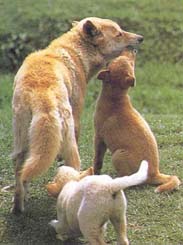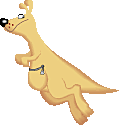 |
 |
 |
 |
 |
 |
 |
 |
 |
 |
 |
 |
 |
 |
 |
 |
 |
 |
 |
 |
 |
 |
 |
 |
 |
 |
 |
 |
 |
 |
 |
 |
 |
 |
 |
 |
 |
 |
 |
 |
 |
 |
 |
 |
 |
 |
 |
 |
 |
 |
 |
 |
 |
 |
 |
 |
 |
 |
 |
 |
 |
 |
 |
 |
 |
 |
 |
 |
|
|
Dingo |
|
|
|
 |
|
|
|
|
Habitat |
|
|
|
|
|
The dingo is found in almost every place in Australia except Tasmania. They live on the main land which provides them water to drink. It needs water and because of this the dingo likes to live in the edge of the forest, but htey are forced to live in semi-arid due to Australian men. |
|
|
|
|
|
|
 |
|
|
|
|
Diet |
|
|
|
|
|
The dingo are carnivores (meat eating) predators which they hunt mostly at night. The dingo likes mammals but they can eat lizards. The mammals they eat are usually small, like rabbits, but they do hunt on kangraroos and eat sheep too. |
|
|
|
|
|
|
 |
|
|
Life Span |
|
|
|
|
|
The dingo usually live up to 15 years in captivity, but they can live longer. |
|
|
|
|
|
Adaptation for Surival |
|
|
|
|
|
They apdapt for surivial with their fur coats and they also apdapt because they have sharp teeth which is good for chewing. They are also very strong. |
|
|
|
|
|
|
Size |
|
|
|
 |
|
|
|
|
The dingo's average body lenght is 117-124cm and its height standing up is 50cm. Its average weight is 10-20 kgs. (kilograms) |
|
|
|
|
|
Position on Food Web/Chain |
|
|
|
|
|
 |
|
|
|
 |
|
|
|
|
|
 |
|
|
|
|
 |
|
|
|
|
|
|
|
|
|
|
|
|
|
|
|
|
 |
|
|
|
|
|
 |
|
|
|
|
|
|
|
|
|
|
|
|
|
|
|
^ |
|
|
|
|
|
|
|
^ |
|
|
|
|
|
|
 |
|
|
|
|
|
 |
|
 |
|
|
|
 |
|
|
|
|
|
 |
|
|
|
|
|
|
|
 |
|
|
|
|
|
Water + Sunlight |
|
|
|
|
|
|
|
|
 |
|
|
|
|
|
 |
|
|
|
|
|
|
|
|
|
|
|
|
|
|
|
|
|
|
|
|
|
|
|
|
|
|
|
|
|
|
|
|
|
The dingo eats rabbits and kangraoos. The rabbit eats carrots and the kangaroo eats grass. Both of that comes from water and sunlight. |
|
|
|
|
|
|

|
|
|
|















